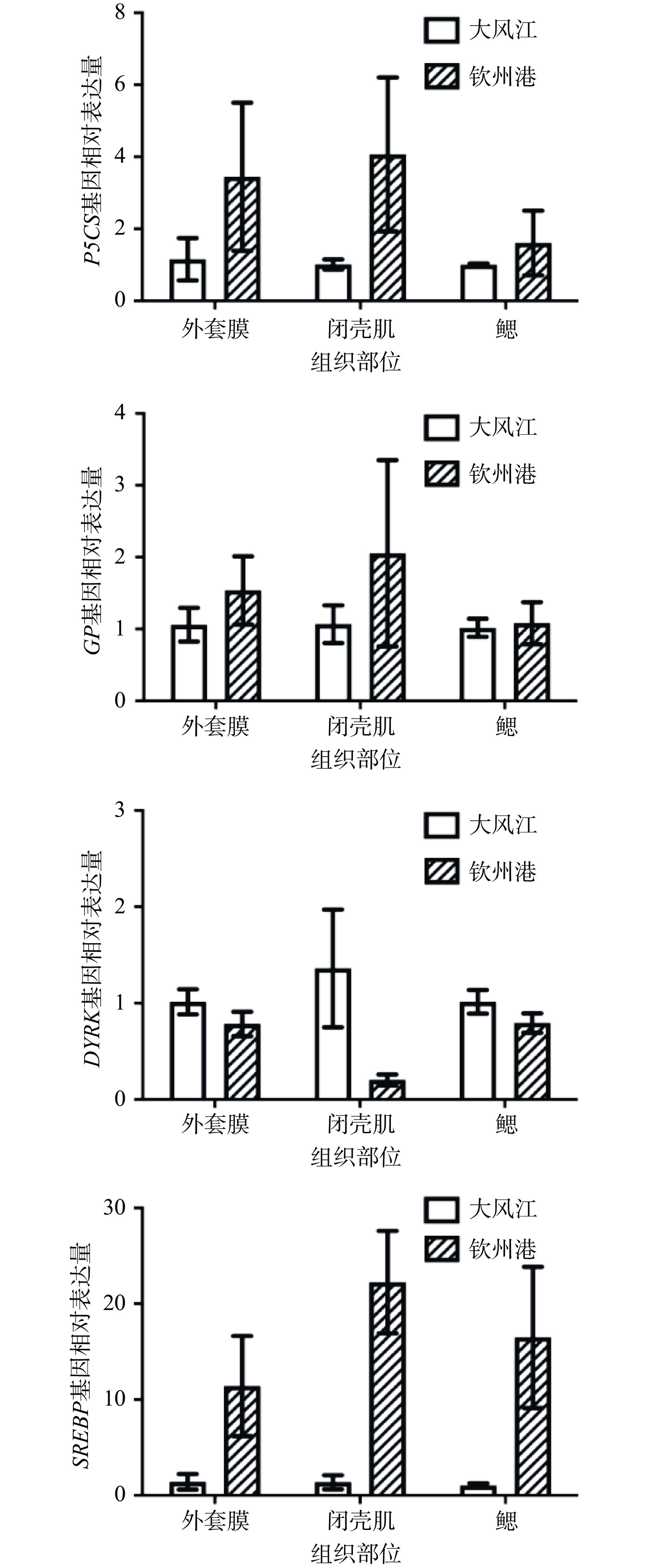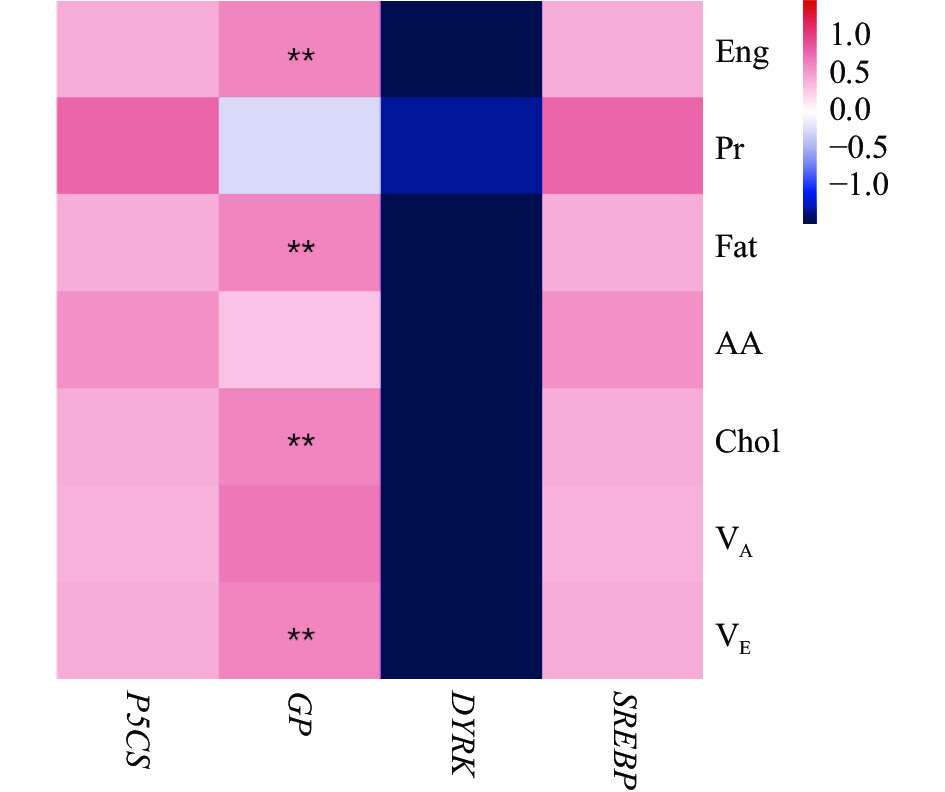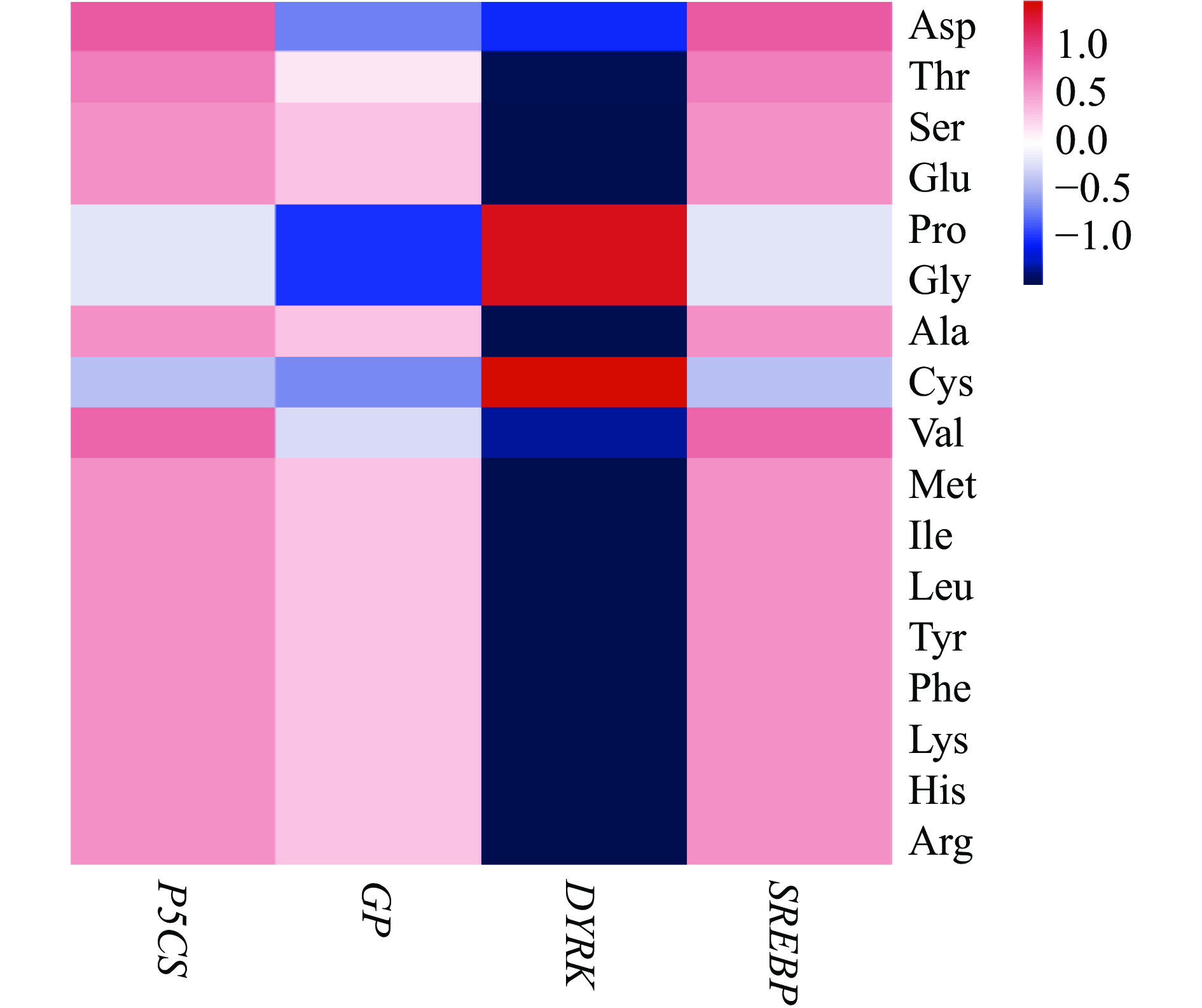Correlation Analysis between Nutritional Evaluation and Gene Expression of Crassostrea hongkongensis in Different Fattening Sea Areas
-
摘要: 本文分析和评价了广西钦州湾两个牡蛎育肥养殖海区中香港牡蛎的营养成分,同时分析了香港牡蛎外套膜、闭壳肌和鳃等组织中相关代谢基因的表达情况,并在此基础上探讨营养成分含量与基因表达之间的相关性。结果显示:钦州港养殖区香港牡蛎的胆固醇、维生素A、维生素E和锌元素的含量以及苯丙氨酸、组氨酸、谷氨酸和丙氨酸等氨基酸含量显著高于大风江养殖区(P<0.05),并且其必需氨基酸的比例(35.51%)和半必需氨基酸的比例(10.51%)也高于大风江养殖区(34.06%,9.31%);但大风江养殖区香港牡蛎的钙、钠和镁等矿物元素的含量和风味氨基酸比例(41.33%)等方面则更有优势。基因表达及相关性分析结果显示,钦州港养殖区香港牡蛎的P5CS、GP和SREBP等基因的相对表达量高于大风江养殖区,而DYRK基因的组织表达结果则低于大风江养殖区,但组间差异均不显著(P>0.05);P5CS、GP和SREBP这3个基因的表达量与常规营养成分和多种氨基酸的含量整体呈正相关关系,其中GP基因与能量、脂肪、胆固醇和维生素等指标呈极显著正相关(P<0.01);而DYRK基因的表达量与多种营养成分及14种氨基酸的含量呈负相关关系。综上所述,钦州湾两个育肥养殖海区香港牡蛎的营养成分和基因表达存在一定的差异,不同海区育肥后的香港牡蛎分别在营养价值和风味口感上各具特色,两个海域均可用于香港牡蛎的育肥养殖。Abstract: In the present study, the nutrient composition of Crassostrea hongkongensis from two oyster fattening areas in Qinzhou Bay, Guangxi was evaluated. And then the metabolism-related gene expression in the mantle, adductor muscle and gill tissues of C. hongkongensis was
analyzed, and the correlation between nutrient composition and gene expression was discussed. The results showed that the contents of cholesterol, vitamin A, vitamin E, zinc and some amino acids including phenylalanine, histidine, glutamic acid and alanine of C. hongkongensis in Qinzhou Port fattening area were significantly higher than those in Dafeng River fattening area (P<0.05). And the proportion of essential amino acids (35.51%) and the proportion of half-essential amino acids (10.51%) of C. hongkongensis in Qinzhou Port fattening area were also higher than those in Dafeng River fattening area (34.06%, 9.31%). Conversely, the contents of calcium, sodium, magnesium and the proportion of flavor development amino acids (41.33%) of C. hongkongensis in Dafeng River fattening area were better. Moreover, the gene expression of P5CS, GP and SREBP of C. hongkongensis in Qinzhou Port fattening area were higher than those in Dafeng River fattening area, while the gene expression of DYRK was lower, but the differences were not significant (P>0.05). The heat map of Spearman correlation showed that the gene expression of P5CS, GP and SREBP were positively correlated with the contents of multiple nutrient composition and amino acids, in which the gene expression of GP was significantly positively correlated with energy, fat, cholesterol and vitamins (P<0.01), but the gene expression of DYRK was negatively correlated with the contents of various nutrients and 14 amino acids. In conclusion, there were certain differences existed in the contents of nutrient composition and the metabolism-related gene expression of C. hongkongensis from two oyster fattening areas in Qinzhou Bay, which had own characteristics in nutritional value and flavor taste separately, and both oyster culture areas could be used for fattening and breeding of C. hongkongensis. -
香港牡蛎(Crassostrea hongkongensis),俗称生蚝或大蚝,隶属双壳纲(Bivalvia)牡蛎科(Ostreidae),其肉质鲜美、营养丰富,干肉中含有蛋白质45%~57%、脂肪7%~11%、糖元20%~40%,还富含多种维生素、必需氨基酸、牛磺酸以及钙、锌、硒等微量矿物元素,具有较高的营养价值[1]。香港牡蛎属于暖水性近岸海域滩涂生长品种,适宜盐度范围为5‰~25‰,主要分布于我国南方沿海地区,是广西贝类养殖的主导品种[2]。目前,广西香港牡蛎成品蚝的养殖方式采取了每年秋、冬季节(10~11月份)在近岸或湾外开放性海域投放大规格牡蛎苗,进行异地养成和育肥养殖的方法,从而快速获得满足上市规格的肥蚝[3]。相关研究表明,牡蛎主要营养成分含量会随着生长时期的不同而呈现季节性变化[4],生长海域的水质、盐度、温度、饵料种类和营养组成等因素都会对香港牡蛎的生化组成和品质产生一定的影响[5-7]。目前,关于香港牡蛎营养品质的分析虽有报道,但针对不同育肥养殖海区中育肥期香港牡蛎的营养组成和相关代谢基因的表达差异以及两者之间的相关性等进行系统比较分析尚未有深入研究。
广西钦州是我国著名的“大蚝之乡”,钦州湾水质优良,饵料丰富,是适宜香港牡蛎繁育生长的天然牧场,也是香港牡蛎的主产区及苗种供应地。钦州湾的牡蛎育肥养殖海区主要分布在大风江和钦州港海域,均属于海河口交界处,具有海水盐度适中,饵料丰富等特点。因此,本文以育肥期的香港牡蛎为研究对象,对广西钦州湾海域的大风江和钦州港两个育肥养殖海区的香港牡蛎主要营养成分、矿物元素、氨基酸含量和营养代谢相关基因的表达情况进行比较和相关性分析,为了解不同育肥养殖海区香港牡蛎的营养结构组成和相关遗传背景,以及全面评价育肥期香港牡蛎的营养价值及营养评价候选基因的筛选奠定理论基础,从而进一步为香港牡蛎深加工及资源合理开发利用提供科学依据。
1. 材料与方法
1.1 材料与仪器
实验所用香港牡蛎样品 分别采集于广西钦州湾大风江牡蛎育肥养殖海区(简称大风江养殖区,N 21°38′24.10″,E 108°52′27.91″)和钦州港牡蛎育肥养殖海区(简称钦州港养殖区,N 21°44′22.31″,E 108°34′4.28″),规格大小为:壳高10~15 cm、壳长6~8 cm、壳宽4~6 cm、软体组织重量30~40 g;石油醚、盐酸、硼酸、氢氧化钠、硫酸钾、硝酸银 分析纯,天津大茂化学试剂厂;TransZol RNA提取试剂盒、Trans Script All-in-one First-Strand cDNA Synthesis Super Mix for qPCR试剂盒、PerfectStartTM Green qPCR SuperMix试剂盒 北京全式金生物公司。
GZX-GF101-3-BS电热恒温鼓风干燥箱 上海跃进医疗器械有限公司;B180马弗炉 德国纳博热公司;消化炉 上海洪纪仪器设备有限公司;KDN-815定氮仪、SZC101S1脂肪测定仪 上海纤检仪器有限公司;HITACHI高速冷冻离心机 日本日立公司;Light Cycler 96实时荧光PCR仪 瑞士罗氏公司。
1.2 实验方法
1.2.1 样品的处理
分别于大风江养殖区和钦州港养殖区采集30个育肥期(11~12月份)的香港牡蛎样品,所有样品均活体开壳取出全部软体组织,每组随机选取6个牡蛎个体采集新鲜的外套膜、闭壳肌和鳃等组织样品,置于液氮中冷冻后于−80 ℃的条件下保存待测;其余牡蛎样品均取其整体的软体组织,进行组内样品混合和匀浆后于−20 ℃的条件下保存待测。
1.2.2 指标的测定
1.2.2.1 常规营养成分测定
香港牡蛎组织中的常规营养成分含量参照食品安全国家标准进行测定,其中能量参照GB 28050-2011(修订版)进行测定;蛋白质参照GB 5009.5-2016(第一法)进行测定;脂肪参照GB 5009.6-2016(第二法)进行测定;氨基酸组分和含量参照GB 5009.124-2016进行测定;胆固醇参照GB 5009.128-2016(第二法)进行测定;维生素A和维生素E参照GB 5009.82-2016(第一法)进行测定。
1.2.2.2 矿物元素测定
香港牡蛎组织中的钙(Ca)、锌(Zn)、钠(Na)、镁(Mg)等矿物元素含量均参照食品安全国家标准GB 5009.82-2016(第二法)进行测定。
1.2.2.3 氨基酸测定与营养价值评定分析
香港牡蛎组织中的氨基酸组分和质量分析参照GB 5009.124-2016进行测定和分析;根据1973年FAO/WHO提出的氨基酸计分模式和中国预防医学科学院营养与食品卫生研究所提出的鸡蛋蛋白模式进行比较,并计算氨基酸评分(amino acid score,AAS)和化学评分(chemical score,CS)[8]。
AAS和CS的计算公式分别为:
AAS=被测蛋白质氨基酸含量(mg/g N)/FAO/WHO评分标准模式中相应氨基酸含量(mg/g N);
CS=被测蛋白质氨基酸含量(mg/g N)/鸡蛋蛋白质中相应氨基酸含量(mg/g N)。
1.2.3 香港牡蛎组织相关基因的表达分析
1.2.3.1 总RNA提取和cDNA合成
参照Trizol法[9]利用TransZol RNA提取试剂盒进行组织总RNA的提取,并根据RNA反转录试剂盒进行cDNA第1链的合成。
1.2.3.2 引物设计和实时荧光定量聚合酶链式反应(PCR)
根据美国国家生物信息中心(NCBI)上公布的牡蛎基因序列和相关参考文献[10-12],设计并合成荧光定量PCR引物,如表1所示。实时荧光定量PCR的反应体系(20 μL)为:上、下游引物各0.5 μL,cDNA模板2 μL,2×TransStart Tip Green qPCR SuperMix反应液10 μL,无核酸酶水7 μL;反应程序为:94 ℃预变性30 s,94 ℃ 5 s、58 ℃ 15 s、72 ℃ 10 s扩增40个循环;以翻译延伸因子1A(EF1A)为内参基因,采用2−ΔΔCt计算目的基因的相对表达量。
表 1 实时荧光定量PCR引物Table 1. The primer sequences for quantitative RT-PCR基因 上游引物序列
(5’→3’)下游引物序列
(5’→3’)EF1A GCCCAGGTCATCATCTTGAA GCAGGCAATGTGAGCAGTG P5CS CAAAACTGCCCAGGTTCTCATC CTCCTTCAGCGTCCCTATCAA GP AAATCAGTATTCGTGGTATTGCTCC TGTCGCCACATTTCTATCTTTCA DYRK CACAGAGGGTGGTAAGCTGGTAG CCCGTGTTGATGGTGGAATAG SREBP AAAGGTGGTGATGAGTTGGGACA CAGTGAGTAGATCCGTGAGTATTTGAC 1.2.4 香港牡蛎代谢基因表达和营养成分相关性分析
利用SPSS软件对香港牡蛎代谢基因的相对表达量和营养成分的数据进行斯皮尔曼(Spearman)相关性分析,P<0.05表示差异显著,P<0.01表示差异极显著。
1.3 数据处理
采用Excel、SPSS、GraphPad Prism 5和OmicShare Tools等软件或在线工具进行数据统计分析和图片处理,数据结果以“平均值±标准误(Mean±SEM)”表示,显著性分析采用配对样品T检验,P<0.05表示差异显著,P<0.01表示差异极显著。
2. 结果与分析
2.1 不同育肥养殖海区香港牡蛎常规营养成分和矿物元素含量分析
研究显示,牡蛎软体组织中糖原具有呈味作用[13],是影响牡蛎风味特征的重要因子[14],而水分含量则会影响牡蛎肉的湿度和多汁性,脂肪含量的变化也会赋予牡蛎不同的坚实度和口感[15]。由表2可知,钦州湾两个养殖海区育肥期的香港牡蛎在能量、蛋白质、脂肪、氨基酸、胆固醇和维生素等营养成分含量均存在不同程度的差异;其中,钦州港养殖区香港牡蛎的能量、蛋白质、脂肪、氨基酸、胆固醇、维生素A和维生素E等成分的含量均高于大风江养殖区,且胆固醇、维生素A和维生素E的含量组间差异显著(P<0.05),这3种成分的含量分别是大风江养殖区的1.9、1.7和1.6倍;表明钦州湾不同育肥海区养殖的香港牡蛎的常规营养成分含量存在一定的差异,这可能与不同海域的海水理化环境存在差异有关。因为牡蛎属于变渗透压动物,需要调整其生理代谢和能量分配来适应不同的盐度和环境的变化,从而影响了自身的营养成分结构和含量[16]。本试验结果与丁丹勇等[17]的研究相似,该研究认为钦州、湛江东海岛、湛江官渡、阳西养殖区香港牡蛎的营养成分存在显著差异,这可能与不同养殖区海水的盐度差异有关。
表 2 钦州湾不同养殖区香港牡蛎常规营养成分含量Table 2. The main nutritional composition contents of C. hongkongensis from different culture areas研究表明,牡蛎中含有丰富的钙、铁、锌、硒、钾、钠、镁等人体生理功能重要的矿物质元素[18-20];其中,牡蛎组织中的微量元素锌和硒是海产品含量之首[5],锌对人体的免疫功能起着调节作用,具有“生命之花”的美称[21];牡蛎还因其富含钙和锌等矿物质元素而被称为“海中牛奶”[22]。由表3可知,大风江养殖区香港牡蛎的钙、钠和镁等矿物元素的含量均显著高于钦州港养殖区(P<0.05),分别是钦州港养殖区的2.4、2.2和1.6倍;而钦州港养殖区香港牡蛎的锌元素含量则显著高于大风江养殖区(P<0.05),为大风江养殖区的1.7倍。这可能是由于牡蛎对不同元素的累积与其所在海域的矿物元素含量存在着一定的差异有关,且部分元素间的累积存在相互竞争或抑制作用[23]。林海生等[14]等研究也认为牡蛎中金属元素的含量具有一定的地域差异,其原因与牡蛎品种、生长周期及其生长海域环境中的矿物元素种类有关。
表 3 钦州湾不同养殖区香港牡蛎主要矿物元素含量Table 3. The main mineral element contents of C. hongkongensis from different culture areas矿物元素 大风江 钦州港 钙(mg/kg) 1550.0±360.0b 652.5±16.5a 锌(mg/kg) 188.5±3.5a 314.0±3.0b 钠(mg/100 g) 574.5±16.5b 256.0±13.0a 镁(mg/kg) 819.5±22.5b 509.0±5.0a 2.2 不同育肥养殖海区香港牡蛎氨基酸组成及营养价值分析
不同育肥养殖海区香港牡蛎氨基酸组成及含量如表4所示,除了色氨酸被酸水解外,钦州湾两个养殖区香港牡蛎组织中检测出了17种常见氨基酸,包括7种必需氨基酸、2种半必需氨基酸和8种非必需氨基酸,氨基酸总量为7.84~8.66 g/100 g,其中谷氨酸的含量最高,胱氨酸的含量最低。在两个养殖区香港牡蛎的氨基酸组成比较中,钦州港养殖区香港牡蛎的苯丙氨酸、组氨酸、谷氨酸和丙氨酸等氨基酸含量显著高于大风江养殖区(P<0.05),其它氨基酸含量差异不显著。氨基酸是牡蛎的一种重要渗透压效应物,牡蛎机体可通过氨基酸的代谢来调节体内的渗透压,因此不同海区的牡蛎也会因其生长环境的不同而在氨基酸的组成和含量方面存在差异[24]。
表 4 钦州湾不同养殖区香港牡蛎氨基酸组成及含量Table 4. Amino acid composition and contents of C. hongkongensis from different culture areas氨基酸种类 大风江(g/100 g) 钦州港(g/100 g) 必需
氨基酸亮氨酸(Leu) 0.54±0.025a 0.61±0.02a 赖氨酸(Lys) 0.55±0.015a 0.64±0.03a 苯丙氨酸(Phe) 0.33±0.015a 0.43±0.01b 异亮氨酸(Ile) 0.32±0.02a 0.37±0.02a 缬氨酸(Val) 0.34±0.01a 0.36±0.02a 苏氨酸(Thr) 0.38±0.02a 0.41±0.02a 蛋氨酸(Met) 0.23±0.02a 0.27±0.01a 半必需氨基酸 组氨酸(His) 0.20±0.01a 0.28±0.02b 精氨酸(Arg) 0.53±0.04a 0.63±0.02a 非必需氨基酸 天冬氨酸(Asp)△ 0.88±0.04a 0.89±0.03a 谷氨酸(Glu)△ 1.16±0.025a 1.36±0.04b 甘氨酸(Gly)△ 0.67±0.02a 0.63±0.06a 丙氨酸(Ala)△ 0.54±0.01a 0.62±0.01b 胱氨酸(Cys) 0.10±0.03a 0a 酪氨酸(Tyr) 0.30±0.035a 0.36±0.02a 丝氨酸(Ser) 0.38±0.01a 0.42±0.01a 脯氨酸(Pro) 0.44±0.03a 0.42±0.03a 注:“△”表示风味氨基酸(FAA)。 牡蛎蛋白质的营养价值主要取决于其氨基酸种类的齐全程度和必需氨基酸含量的高低[20]。由表5可知,钦州港养殖区香港牡蛎的必需氨基酸含量为3.08 g/100 g,占氨基酸总量的35.51%,与WHO/FAO模式推荐的模式(35.38%)接近[25];而大风江养殖区香港牡蛎的必需氨基酸含量和比例分别为2.67 g/100 g和34.06%,稍低于钦州港养殖区。钦州港养殖区香港牡蛎半必需氨基酸为0.91 g/100 g(10.51%),同样高于大风江养殖区(0.73 g/100 g,9.31%)。
表 5 钦州湾不同养殖区香港牡蛎氨基酸组成评价Table 5. Evaluation of amino acid composition in C. hongkongensis from different culture areas氨基酸 大风江 钦州港 氨基酸总量(TAA,g/100 g) 7.84 8.66 必需氨基酸含量(EAA,g/100 g) 2.67 3.08 必需氨基酸比例(EAA/TAA,%) 34.06 35.51 半必需氨基酸含量(HEAA,g/100 g) 0.73 0.91 半必需氨基酸比例(HEAA/TAA,%) 9.31 10.51 非必需氨基酸含量(NEAA,g/100 g) 4.45 4.69 非必需氨基酸比例(NEAA/TAA,%) 56.70 54.10 风味氨基酸含量(FAA,g/100 g) 3.24 3.50 风味氨基酸比例(FAA/TAA,%) 41.33 40.42 为进一步评价香港牡蛎蛋白质营养价值的高低,采用FAO/WHO评分模式和鸡蛋蛋白的必需氨基酸含量作标准计算,钦州湾不同养殖区香港牡蛎的氨基酸评分(AAS)和化学评分(CS)结果详见表6。根据必需氨基酸组成评价,大风江养殖区香港牡蛎缬氨酸的AAS和CS评分最低,为第一限制氨基酸;钦州港养殖区香港牡蛎的第一限制氨基酸则为缬氨酸(AAS)和蛋氨酸+胱氨酸(CS)。根据AAS评分,钦州港养殖区香港牡蛎的异亮氨酸、亮氨酸、赖氨酸、苯丙氨酸+酪氨酸、苏氨酸的AAS评分均高于大风江养殖区,其中AAS评分最高的是苯丙氨酸+酪氨酸(1.35);根据CS评分,钦州港养殖区香港牡蛎的异亮氨酸、亮氨酸、赖氨酸、苯丙氨酸+酪氨酸、苏氨酸的CS评分也高于大风江养殖区,其中CS评分最高的是赖氨酸(0.94)。因此,钦州港养殖区香港牡蛎的氨基酸平衡效果相对更好,含量丰富且均匀,蛋白质质量好,均属于优质的蛋白质,具有较高的营养价值。
表 6 钦州湾不同养殖区香港牡蛎必需氨基酸评分Table 6. Scores of essential amino acids of C. hongkongensis from different culture areas必需氨基酸 FAO/WHO模式N质量分数 鸡蛋蛋白模式N质量分数 大风江 钦州港 AAS CS AAS CS 异亮氨酸 250 331 0.89 0.67 0.97 0.73 亮氨酸 440 534 0.84 0.69 0.90 0.74 赖氨酸 340 441 1.11 0.86 1.22 0.94 蛋氨酸+胱氨酸 220 386 1.02 0.58 0.80 0.46 苯丙氨酸+酪氨酸 380 565 1.13 0.76 1.35 0.91 苏氨酸 250 292 1.04 0.89 1.06 0.91 缬氨酸 310 411 0.76 0.57 0.76 0.57 牡蛎的鲜美口感还在一定程度上取决于谷氨酸、天冬氨酸、甘氨酸和丙氨酸等4种风味氨基酸的组成和含量,其中谷氨酸和天冬氨酸是呈鲜味的特征氨基酸,而甘氨酸和丙氨酸则是呈甘味的特征氨基酸[17,26]。钦州湾两个养殖区香港牡蛎的风味氨基酸的总含量为3.24~3.50 g/100 g,钦州港养殖区香港牡蛎的天冬氨酸、谷氨酸和丙氨酸的含量以及风味氨基酸总量(3.50 g/100 g)均高于大风江养殖区(3.24 g/100 g),但风味氨基酸占氨基酸总量的比例(40.42%)却低于大风江养殖区(41.33%),表明大风江养殖区香港牡蛎的鲜美程度相对较高。黄艳球等[27]对比了广西钦州、广东阳江、广东湛江和广东汕头四个养殖区的香港牡蛎的氨基酸组成和含量,也发现钦州大蚝在氨基酸总量、必需氨基酸、非必需氨基酸含量以及在风味氨基酸天冬氨酸、谷氨酸、甘氨酸、丙氨酸含量方面都具有明显的优势。
2.3 不同育肥养殖海区香港牡蛎营养代谢相关基因组织表达分析
由图1可知,δ-1吡咯啉-5-羧酸合成酶(delta-1-pyrroline-5-carboxylate synthase,P5CS)、糖原磷酸酶(glycogen phosphorylase,GP)、双特异性酪氨酸磷酸化调节激酶(dual-specificity tyrosine-phosphorylation-regulated kinase,DYRK)和胆固醇调节元件结合蛋白(sterol-regulatory element binding protein,SREBP)等四个营养代谢相关基因的相对表达量在香港牡蛎外套膜、闭壳肌和鳃等不同组织的组间表达趋势完全一致,均表现为在同组不同组织内整体呈上调或下调趋势;其中,钦州港养殖区香港牡蛎的P5CS、GP和SREBP的基因相对表达量高于大风江组,而DYRK基因的组织表达结果则低于大风江养殖区,但组间差异均不显著(P>0.05)。
P5CS基因是氨基酸代谢过程的关键酶,可以催化谷氨酸还原,该步骤是合成脯氨酸、鸟氨酸和精氨酸的关键步骤[28]。钦州港养殖区香港牡蛎的P5CS基因在外套膜、闭壳肌和鳃等组织的相对表达量分别是大风江组的3.0、4.0和1.6倍,表明钦州港养殖区香港牡蛎在氨基酸代谢及合成脯氨酸、鸟氨酸和精氨酸等方面更有优势。GP基因与葡萄糖代谢相关,琥珀酸脱氢酶在三羧酸循环中可以催化琥珀酸氧化成延胡索酸[29],而GP通过释放葡萄糖-1-磷酸催化糖原分解,是这个过程的限速步骤[30]。钦州港组GP基因在外套膜、闭壳肌和鳃等组织的相对表达量分别是大风江组的1.4、1.9和1.0倍,表明钦州港养殖区香港牡蛎具有更强的葡萄糖代谢能力。
DYRK基因是一种剂量依赖性的丝氨酸/苏氨酸激酶,在细胞增殖和分化的调控中起着关键作用,该基因家族成员可磷酸化许多底物,包括细胞周期的关键调节因子[31],可以通过减少体脂来抑制肥胖等代谢病[32]。此外,李春燕[11]通过Quantitative trait locus(QTL)分析认为DYRK基因是可影响牡蛎生长和脂肪酸性状的重要标记基因。SREBP基因是内质网膜上的转录因子,可以激活下游的脂肪合成相关酶基因,促进脂质的合成与沉积[33-37]。大风江养殖区香港牡蛎的DYRK基因在外套膜、闭壳肌和鳃等组织的相对表达量分别是钦州港养殖区的1.3、6.7和1.3倍,而钦州港养殖区香港牡蛎的SREBP基因在外套膜、闭壳肌和鳃等组织的相对表达量分别是大风江养殖区的8.2、16.4和16.1倍,因此推测大风江养殖区香港牡蛎的脂肪分解代谢能力更强,而钦州港养殖区的香港牡蛎可能在脂肪合成与沉积上更有优势。
2.4 香港牡蛎代谢基因表达和营养成分相关性分析
由图2可知,DYRK的基因表达量和香港牡蛎常规营养成分含量的相关性明显与P5CS、GP和SREBP这3个基因的结果相反,表现为DYRK基因的表达量与能量、蛋白质、脂肪、氨基酸、胆固醇、维生素A和维生素E等含量均呈负相关关系;牡蛎的遗传图谱与营养品质性状QTL定位分析发现DYRK基因与花生四烯酸的代谢相关[11],花生四烯酸是一种ω-6多不饱和脂肪酸,具有酯化胆固醇的作用,因此DYRK基因可能在脂肪酸代谢过程中具有一定的调控作用。P5CS、GP和SREBP这3个基因的表达量则表现为与香港牡蛎的常规营养成分含量整体呈正相关关系,这3个基因的功能分别与氨基酸代谢、葡萄糖代谢及脂质合成有关,相关性分析结果与其基因功能基本相符,表明P5CS、GP和SREBP这3个基因与香港牡蛎的常规营养成分的相关性具有一致性。此外,GP基因的功能与糖原分解和葡萄糖代谢密切相关,而相关性分析结果发现GP基因的表达量与能量、脂肪、胆固醇和维生素E的含量极显著正相关(P<0.01),表明GP基因与香港牡蛎的能量、脂肪、胆固醇和维生素E这4个营养成分指标的相关性较强,进一步说明GP基因是研究香港牡蛎营养代谢的关键候选基因。
香港牡蛎代谢基因表达和17种氨基酸含量的相关性分析结果如图3所示,P5CS、GP和SREBP这3个基因的表达量与苏氨酸、丝氨酸、谷氨酸、丙氨酸、蛋氨酸、异亮氨酸、亮氨酸、酪氨酸、苯丙氨酸、赖氨酸、组氨酸和精氨酸等多种氨基酸的含量整体呈正相关关系;P5CS基因是氨基酸代谢过程的关键酶,对脯氨酸、鸟氨酸和精氨酸的合成具有重要的作用,GP和SREBP的基因功能则分别与葡萄糖代谢和脂肪合成有关,而苯丙氨酸、异亮氨酸、苏氨酸、酪氨酸、色氨酸等生糖氨基酸或生酮氨基酸又可通过不同的途径合成糖类和脂类,因此P5CS、GP和SREBP这3个基因可能参与了多种氨基酸的代谢调控过程[38]。由图3可以看出,DYRK基因的表达量则与脯氨酸、甘氨酸和胱氨酸呈正相关关系,与天冬氨酸、苏氨酸、丝氨酸、谷氨酸、丙氨酸、缬氨酸、蛋氨酸、异亮氨酸、亮氨酸、酪氨酸、苯丙氨酸、赖氨酸、组氨酸和精氨酸等14种氨基酸的含量呈明显的负相关关系,但DYRK基因参与氨基酸代谢过程的调控机制还需要进一步深入研究。综上所述,相关性分析结果表明P5CS、GP和SREBP等基因可能与香港牡蛎的营养成分及多种氨基酸合成和代谢具有一定的正向协同作用。
3. 结论
本研究测定了广西钦州湾两个育肥养殖海区香港牡蛎的营养成分和代谢相关基因的表达情况,并首次分析了育肥期香港牡蛎营养成分和基因表达的相关性。结果显示,大风江和钦州港两个育肥养殖海区的香港牡蛎的组织营养成分存在一定的差异:与大风江养殖区相比,钦州港养殖区香港牡蛎的必需氨基酸的含量和比例以及必需氨基酸评分更高,表明其氨基酸平衡效果好,含量丰富且均匀,属于优质的蛋白质,具有较高的营养价值;而大风江养殖区香港牡蛎在钙、钠和镁等矿物元素的含量上更有优势,且其风味氨基酸的比例高于钦州港养殖区牡蛎,表明大风江养殖区香港牡蛎鲜味程度更佳。此外,基因表达及相关性分析结果表明,钦州港养殖区的香港牡蛎可能在涉及氨基酸、葡萄糖等营养物质代谢和脂肪合成等方面的基因表达量更高,而大风江养殖区香港牡蛎的DYRK基因表达量更高,提示其在脂肪分解代谢及脯氨酸、甘氨酸和胱氨酸合成等方面的基因表达上更有优势。本研究为全面认识不同海区育肥期香港牡蛎的营养特征及营养评价候选基因的筛选提供了理论依据,对香港牡蛎深加工及资源合理开发利用具有一定的参考价值。
-
表 1 实时荧光定量PCR引物
Table 1 The primer sequences for quantitative RT-PCR
基因 上游引物序列
(5’→3’)下游引物序列
(5’→3’)EF1A GCCCAGGTCATCATCTTGAA GCAGGCAATGTGAGCAGTG P5CS CAAAACTGCCCAGGTTCTCATC CTCCTTCAGCGTCCCTATCAA GP AAATCAGTATTCGTGGTATTGCTCC TGTCGCCACATTTCTATCTTTCA DYRK CACAGAGGGTGGTAAGCTGGTAG CCCGTGTTGATGGTGGAATAG SREBP AAAGGTGGTGATGAGTTGGGACA CAGTGAGTAGATCCGTGAGTATTTGAC 表 2 钦州湾不同养殖区香港牡蛎常规营养成分含量
Table 2 The main nutritional composition contents of C. hongkongensis from different culture areas
表 3 钦州湾不同养殖区香港牡蛎主要矿物元素含量
Table 3 The main mineral element contents of C. hongkongensis from different culture areas
矿物元素 大风江 钦州港 钙(mg/kg) 1550.0±360.0b 652.5±16.5a 锌(mg/kg) 188.5±3.5a 314.0±3.0b 钠(mg/100 g) 574.5±16.5b 256.0±13.0a 镁(mg/kg) 819.5±22.5b 509.0±5.0a 表 4 钦州湾不同养殖区香港牡蛎氨基酸组成及含量
Table 4 Amino acid composition and contents of C. hongkongensis from different culture areas
氨基酸种类 大风江(g/100 g) 钦州港(g/100 g) 必需
氨基酸亮氨酸(Leu) 0.54±0.025a 0.61±0.02a 赖氨酸(Lys) 0.55±0.015a 0.64±0.03a 苯丙氨酸(Phe) 0.33±0.015a 0.43±0.01b 异亮氨酸(Ile) 0.32±0.02a 0.37±0.02a 缬氨酸(Val) 0.34±0.01a 0.36±0.02a 苏氨酸(Thr) 0.38±0.02a 0.41±0.02a 蛋氨酸(Met) 0.23±0.02a 0.27±0.01a 半必需氨基酸 组氨酸(His) 0.20±0.01a 0.28±0.02b 精氨酸(Arg) 0.53±0.04a 0.63±0.02a 非必需氨基酸 天冬氨酸(Asp)△ 0.88±0.04a 0.89±0.03a 谷氨酸(Glu)△ 1.16±0.025a 1.36±0.04b 甘氨酸(Gly)△ 0.67±0.02a 0.63±0.06a 丙氨酸(Ala)△ 0.54±0.01a 0.62±0.01b 胱氨酸(Cys) 0.10±0.03a 0a 酪氨酸(Tyr) 0.30±0.035a 0.36±0.02a 丝氨酸(Ser) 0.38±0.01a 0.42±0.01a 脯氨酸(Pro) 0.44±0.03a 0.42±0.03a 注:“△”表示风味氨基酸(FAA)。 表 5 钦州湾不同养殖区香港牡蛎氨基酸组成评价
Table 5 Evaluation of amino acid composition in C. hongkongensis from different culture areas
氨基酸 大风江 钦州港 氨基酸总量(TAA,g/100 g) 7.84 8.66 必需氨基酸含量(EAA,g/100 g) 2.67 3.08 必需氨基酸比例(EAA/TAA,%) 34.06 35.51 半必需氨基酸含量(HEAA,g/100 g) 0.73 0.91 半必需氨基酸比例(HEAA/TAA,%) 9.31 10.51 非必需氨基酸含量(NEAA,g/100 g) 4.45 4.69 非必需氨基酸比例(NEAA/TAA,%) 56.70 54.10 风味氨基酸含量(FAA,g/100 g) 3.24 3.50 风味氨基酸比例(FAA/TAA,%) 41.33 40.42 表 6 钦州湾不同养殖区香港牡蛎必需氨基酸评分
Table 6 Scores of essential amino acids of C. hongkongensis from different culture areas
必需氨基酸 FAO/WHO模式N质量分数 鸡蛋蛋白模式N质量分数 大风江 钦州港 AAS CS AAS CS 异亮氨酸 250 331 0.89 0.67 0.97 0.73 亮氨酸 440 534 0.84 0.69 0.90 0.74 赖氨酸 340 441 1.11 0.86 1.22 0.94 蛋氨酸+胱氨酸 220 386 1.02 0.58 0.80 0.46 苯丙氨酸+酪氨酸 380 565 1.13 0.76 1.35 0.91 苏氨酸 250 292 1.04 0.89 1.06 0.91 缬氨酸 310 411 0.76 0.57 0.76 0.57 -
[1] 钟方杰, 覃波忠, 李选积, 等. 广西钦州大蚝产业发展形势分析[J]. 中国水产,2019(4):53−55. [ZHONG Fangjie, QIN Bozhong, LI Xuanji, et al. Analysis on industrial development situation of Qinzhou oyster in Guangxi[J]. China fisheries,2019(4):53−55. ZHONG Fangjie, QIN Bozhong, LI Xuanji, et al. Analysis on industrial development situation of Qinzhou oyster in Guangxi[J]. China fisheries, 2019(4): 53-55.
[2] 谢忠明. 海水经济贝类养殖技术(上册)[M]. 北京: 中国农业出版社, 2003 XIE Zhongming. Culture technology of marine economic shellfish (Volume 1)[M]. Beijing: China agricultural press, 2003.
[3] 李琼珍, 罗帮, 张兴志, 等. 香港牡蛎分段式高效养殖方法: 中国, CN108112518A[P]. 2018-06-05 LI Qiongzhen, LUO Bang, ZHANG Xingzhi, et al. Segmented and efficient culture method of Hong Kong oyster: China, CN108112518A[P]. 2018-06-05.
[4] 张智翠. 太平洋牡蛎品质的季节性变化及贮藏过程中的生化变化[D]. 青岛: 中国海洋大学, 2006 ZHANG Zhicui. Oyster quality changes during different season and storage[D]. Qingdao: Ocean University of China, 2006.
[5] 秦华伟, 陈爱华, 刘慧慧, 等. 乳山海域养殖太平洋牡蛎中营养成分及重金属含量分析及评价[J]. 中国渔业质量与标准,2015,5(6):64−70. [QIN Huawei, CHEN Aihua, LIU Huihui, et al. Assessment of content of nutrition ingredients and heavy metal in Crassostrea gigas of Rushan[J]. Chinese Fishery Quality and Standards,2015,5(6):64−70. QIN Huawei, CHEN Aihua, LIU Huihui, et al. Assessment of content of nutrition ingredients and heavy metal in Crassostrea gigas of Rushan[J]. Chinese Fishery Quality and Standards, 2015, 5(6): 64-70.
[6] MAËVA Cochet, BROWN Malcolm, KUBE Peter, et al. Understanding the impact of growing conditions on oysters: A study of their sensory and biochemical characteristics[J]. Aquaculture Research,2015,46(3):637−646. doi: 10.1111/are.12210
[7] JASPER Van Houcke, MEDINA Isabel, MAEHRE Hanne-K, et al. The effect of algae diets (Skeletonema costatum and Rhodomonas baltica) on the biochemical composition and sensory characteristics of Pacific cupped oysters (Crassostrea gigas) during land-based refinement[J]. Food Research International,2017,100(pt.1):151.
[8] B-J Vinay, KANYA T-C-Sindhu. Effect of detoxification on the functional and nutritional quality of proteins of karanja seed meal[J]. Food Chemistry,2008,106(1):77−84. doi: 10.1016/j.foodchem.2007.05.048
[9] YAN Xueyu, WEI Lingjing, HUANG Jie, et al. Comparative skin transcriptome between common carp and the variety Jinbian carp (Cyprinus carpio v. jinbian)[J]. Aquaculture research,2020,51(1):187−196. doi: 10.1111/are.14363
[10] 闫路路, 王昭萍, 苏家齐, 等. 熊本牡蛎(♀)×葡萄牙牡蛎(♂)杂交子代的营养成分和脂肪代谢相关基因表达分析[J]. 中国海洋大学学报(自然科学版),2017,47(6):53−60. [YAN Lulu, WANG Zhaoping, SU Jiaqi, et al. Determination of nutritive components and expression analysis of lipid metabolism related genes of hybrid of Kumamoto Oyster(♀) and Portuguese Oyster(♂)[J]. Periodical of Ocean University of China,2017,47(6):53−60. YAN Lulu, WANG Zhaoping, SU Jiaqi, et al. Determination of nutritive components and expression analysis of lipid metabolism related genes of hybrid of Kumamoto Oyster(♀) and Portuguese Oyster(♂)[J]. Periodical of Ocean University of China, 2017, 47(6): 53-60.
[11] 李春燕. 牡蛎营养品质等重要经济性状的遗传定位与基因解析[D]. 北京: 中国科学院大学(中国科学院海洋研究所), 2017 LI Chunyan. Genetic mapping and gene dissection of nutritional and other important economic traits of the oyster[D]. Beijing: University of Chinese Academy of Sciences (Institute of Oceanology, Chinese Academy of Sciences), 2017.
[12] 何金全, 张虹, 佘智彩, 等. 香港牡蛎Foxl2基因克隆分析与表达模式研究[J]. 基因组学与应用生物学,2020,39(4):1519−1528. [HE Jinquan, ZHANG Hong, SHE Zhicai, et al. Cloning and expression pattern investigation of Crassostrea hongkongensis Foxl2 gene[J]. Genomics and Applied Biology,2020,39(4):1519−1528. HE Jinquan, ZHANG Hong, SHE Zhicai, et al. Cloning and expression pattern investigation of Crassostrea hongkongensis Foxl2 gene[J]. Genomics and Applied Biology, 2020, 39(4): 1519-1528.
[13] 王恬, 史博, 周龙, 等. 潮间带和潮下带养殖的福建牡蛎生长、营养及呈味成分的差异分析[J]. 厦门大学学报(自然科学版),2020,59(2):246−253. [WANG Tian, SHI Bo, ZHOU Long, et al. Difference analyses of growth, nutrition and taste components of Crassostrea angulata cultured in intertidal zone and subtidal zone[J]. Journal of Xiamen University (Natural science),2020,59(2):246−253. WANG Tian, SHI Bo, ZHOU Long, et al. Difference analyses of growth, nutrition and taste components of Crassostrea angulata cultured in intertidal zone and subtidal zone[J]. Journal of Xiamen University(Natural science), 2020, 59(2): 246-253.
[14] 林海生, 秦小明, 章超桦, 等. 中国沿海主要牡蛎养殖品种的营养品质和风味特征比较分析[J]. 南方水产科学,2019,15(2):110−120. [LIN Haisheng, QIN Xiaoming, ZHANG Chaohua, et al. Comparative analysis of nutritional components and flavorcharacteristics of cultivated oyster from different coastal areas of China[J]. South China Fisheries Science,2019,15(2):110−120. doi: 10.12131/20180226 LIN Haisheng, QIN Xiaoming, ZHANG Chaohua, et al. Comparative analysis of nutritional components and flavorcharacteristics of cultivated oyster from different coastal areas of China[J]. South China Fisheries Science, 2019, 15(2): 110-120. doi: 10.12131/20180226
[15] DRIDI S, ROMDHANE M S, ELCAFSI M. Seasonal variation in weight and biochemical composition of the Pacific oyster, Crassostrea gigas in relation to the gametogenic cycle and environmental conditions of the Bizert lagoon, Tunisia[J]. Aquaculture,2007,263(1-4):238−248. doi: 10.1016/j.aquaculture.2006.10.028
[16] 杜美荣, 方建光, 葛长字, 等. 盐度和饵料密度对栉孔扇贝稚贝滤水率的影响[J]. 渔业科学进展,2009,30(3):74−78. [DU Meirong, FANG Jianguang, GE Changzi, et al. Effects of salinities and microalgae densities on filtration rates of scallop Chlamys farreri spats[J]. Progress in Fishery Sciences,2009,30(3):74−78. doi: 10.3969/j.issn.1000-7075.2009.03.013 DU Meirong, FANG Jianguang, GE Changzi, et al. Effects of salinities and microalgae densities on filtration rates of scallop Chlamys farreri spats[J]. Progress in Fishery Sciences, 2009, 30(3): 74-78. doi: 10.3969/j.issn.1000-7075.2009.03.013
[17] 丁丹勇, 李长玲, 黄翔鹄, 等. 不同养殖区香港牡蛎营养成分的分析与评价[J]. 安徽农业科学,2018,46(5):91−95. [DING Danyong, LI Changling, HUANG Xianghu, et al. Analysis and Evaluation of nutritive components of Crassostrea hongkongensis from different cultural areas[J]. Journal of Anhui Agricultural Sciences,2018,46(5):91−95. doi: 10.3969/j.issn.0517-6611.2018.05.027 DING Danyong, LI Changling, HUANG Xianghu, et al. Analysis and Evaluation of nutritive components of Crassostrea hongkongensis from different cultural areas[J]. Journal of Anhui Agricultural Sciences, 2018, 46(5): 91-95. doi: 10.3969/j.issn.0517-6611.2018.05.027
[18] ESPAÑA M S A, RODRÍGUEZ E M R, ROMERO C D. Comparison of mineral and trace element concentrations in two molluscs from the Strait of Magellan (Chile)[J]. Journal of Food Composition & Analysis,2007,20(3-4):273−279.
[19] 祁剑飞, 巫旗生, 宁岳, 等. 2个壳色福建牡蛎群体的营养成分差异分析[J]. 厦门大学学报(自然科学版),2019,58(2):276−281. [QI Jianfei, WU Qisheng, NING Yue, et al. Analysis of nutritional component differences between two shell-color groups of Fujian oyster (Crassostrea angulata)[J]. Journal of Xiamen University (Natural Science),2019,58(2):276−281. QI Jianfei, WU Qisheng, NING Yue, et al. Analysis of nutritional component differences between two shell-color groups of Fujian oyster(Crassostrea angulata)[J]. Journal of Xiamen University(Natural Science), 2019, 58(2): 276-281.
[20] 方玲, 马海霞, 李来好, 等. 华南地区近江牡蛎营养成分分析及评价[J]. 食品工业科技,2018,39(2):301−307. [FANG Ling, MA Haixia, LI Laihao, et al. Analysis and evaluation of nutrient composition in Ostrea rivularis from south China sea coast[J]. Science and Technology of Food Industry,2018,39(2):301−307. FANG Ling, MA Haixia, LI Laihao, et al. Analysis and evaluation of nutrient composition in Ostrea rivularis from south China sea coast[J]. Science and Technology of Food Industry, 2018, 39(2): 301-307.
[21] 考希宾, 王治伦, 高艳. 微量元素锌和人体健康[J]. 中国地方病防治杂志,2007(3):192−194. [KAO Xibin, WANG Zhilun, GAO Yan. Trace element zinc and human health[J]. Chinese Journal of Control of Endemic Diseases,2007(3):192−194. doi: 10.3969/j.issn.1001-1889.2007.03.010 KAO Xibin, WANG Zhilun, GAO Yan. Trace element zinc and human health[J]. Chinese Journal of Control of Endemic Diseases, 2007(3): 192-194. doi: 10.3969/j.issn.1001-1889.2007.03.010
[22] 王珏. 三种不同养殖处理的鲜活美东牡蛎(C. virginica)的品质评价及其在冷藏期间品质变化的研究[D]. 上海: 上海海洋大学, 2016 WANG Jue. Quality changes of three different aquaculture-treated live eastern oysters (Crassostrea virginica) during cold storage[D]. Shanghai: Shanghai Ocean University, 2016.
[23] 张聪, 刘程惠, 马坤, 等. 大连湾牡蛎中微量元素的分析[J]. 食品研究与开发,2009,30(7):130−133. [ZHANG Cong, LIU Chenghui, MA Kun, et al. Analysis of trace elements in Dalian bay oysters[J]. Food Research and Development,2009,30(7):130−133. ZHANG Cong, LIU Chenghui, MA Kun, et al. Analysis of trace elements in Dalian bay oysters[J]. Food Research and Development, 2009, 30(7): 130-133.
[24] M Hosoi, KUBOTA S, TOYOHARA M, et al. Effect of salinity change on free amino acid content in Pacific oyster[J]. Fisheries Science,2003,69(2):395−400. doi: 10.1046/j.1444-2906.2003.00634.x
[25] 李晓英, 李勇, 周淑青, 等. 两种淡水螺肉的营养成分分析与评价[J]. 食品科学,2010,31(13):276−279. [LI Xiaoying, LI Yong, ZHOU Shuqing, et al. Analysis and evaluation of nutritional composition in two freshwater fingersnails[J]. Food Science,2010,31(13):276−279. LI Xiaoying, LI Yong, ZHOU Shuqing, et al. Analysis and evaluation of nutritional composition in two freshwater fingersnails[J]. Food Science, 2010, 31(13): 276-279.
[26] MISAKO K, ATSUSHI O, YOICHI U. Taste enhancements between various amino acids and IMP[J]. Chemical Senses,2002(8):739.
[27] 黄艳球, 杨发明, 秦小明, 等. 不同养殖区香港牡蛎的化学组成及特征气味成分分析[J]. 食品科学,2019,40(14):236−242. [HUANG Yanqiu, YANG Faming, QIN Xiaoming, et al. Chemical composition and characteristic odorans of oyster (Crassostrea hongkongensis) from different culture areas[J]. Food Science,2019,40(14):236−242. doi: 10.7506/spkx1002-6630-20180822-239 HUANG Yanqiu, YANG Faming, QIN Xiaoming, et al. Chemical composition and characteristic odorans of oyster (Crassostrea hongkongensis) from different culture areas[J]. Food Science, 2019, 40(14): 236-242. doi: 10.7506/spkx1002-6630-20180822-239
[28] ZHUANG G Q, LI B, GUO H Y, et al. Molecular cloning and characterization of P5CS gene from Jatropha curcas L[J]. African Journal of Biotechnology,2011,10(66):14803−14811.
[29] OYEDOTUN K S, LEMIRE B D. The quaternary structure of theSaccharomyces cerevisiae succinate dehydrogenase: Homology modeling, cofactor docking, and molecular dynamics simulation studies[J]. Journal of Biological Chemistry,2004,279(10):9424−9431. doi: 10.1074/jbc.M311876200
[30] BACCA H, HUVET A, FABIOUX C, et al. Molecular cloning and seasonal expression of oyster glycogen phosphorylase and glycogen synthase genes[J]. Comparative Biochemistry and Physiology Part B: Biochemistry and Molecular Biology,2005,140(4):635−646. doi: 10.1016/j.cbpc.2005.01.005
[31] BECKER W. Emerging role of DYRK family protein kinases as regulators of protein stability in cell cycle control[J]. Cell Cycle,2012,11(18):3389−3394. doi: 10.4161/cc.21404
[32] SONG W J, SONG E A, JUNG M S, et al. Phosphorylation and inactivation of glycogen synthase kinase 3β (GSK3β) by dual-specificity tyrosine phosphorylation-regulated kinase 1A (DYRK1A)[J]. Journal of Biological Chemistry,2015,290(4):2321−2333. doi: 10.1074/jbc.M114.594952
[33] 刘佳, 李传飞, 宁波, 等. 内质网应激通过SCAP/SREBP-1c调控L02肝细胞脂质合成代谢[J]. 第三军医大学学报,2015,37(5):443−448. [LIU Jia, LI Chuanfei, NING Bo, et al. Endoplasmic reticulum stress regulates lipid synthesis metabolism in L02 hepatocytes through SCAP/SREBP-1c[J]. Journal of Third Military Medical University,2015,37(5):443−448. LIU Jia, LI Chuanfei, NING Bo, et al. Endoplasmic reticulum stress regulates lipid synthesis metabolism in L02 hepatocytes through SCAP/SREBP-1c[J]. Journal of Third Military Medical University, 2015, 37(5): 443-448.
[34] 房殿亮. Insig-1/SCAP/SREBP-1c通路对内质网应激下肝细胞脂质代谢的影响[D]. 重庆: 重庆医科大学, 2013 FANG Dianliang. Effect of Insig-1/SCAP/SREBP-1c signal on lipid metabolism in hepatocytes under endoplasmic reticulum stress[D]. Chongqing: Chongqing Medical University, 2013.
[35] 徐丽. 牛SREBP1基因与牛肉肌内脂肪沉积的研究[D]. 北京: 中国农业科学院, 2013 XU Li. Study on beef intramuscular fat deposition of SREBP1 gene in cattle[D]. Beijing: Chinese Academy of Agricultural Sciences, 2013.
[36] 杨林辉. TNF-α对肝细胞脂肪变性模型SCAP-SREBP-1c脂质合成通路的影响[D]. 重庆: 第三军医大学, 2006 YANG Linhui. Effect of TNF-α on the SCAP-SREBP-1c pathway of lipid synthesis in a model of hepatocyte steatosis[D]. Chongqing: Chongqing Medical University, 2006.
[37] 王媛媛. SCAP超表达对细胞脂代谢的影响及其相关可能机制研究[D]. 重庆: 重庆医科大学, 2010 WANG Yuanyuan. Construction of pcDNA-SM22-SCAP(D443N) eukaryotic expression vector and its investigation of function[D]. Chongqing: Chongqing Medical University, 2010.
[38] 单毓娟, 孙长颢. 氨基酸对基因表达的调控作用及其机制研究进展[J]. 营养健康新观察,2004(4):27−31. [SHAN Yujuan, SUN Changhao. Regulation of amino acids on gene expression and its mechanism[J]. New Observations on Nutrition and Health,2004(4):27−31. SHAN Yujuan, SUN Changhao. Regulation of amino acids on gene expression and its mechanism[J]. New Observations on Nutrition and Health, 2004(4): 27-31.
-
期刊类型引用(3)
1. 蒋美君,张启元,蒙扬辉,白科,张兴志,农珍珍,钟方杰,朱鹏,彭金霞,官俊良,严雪瑜. 香港牡蛎BMP7基因克隆与表达. 广东海洋大学学报. 2023(04): 129-136 .  百度学术
百度学术
2. 周晖,汤保贵,伍栩民,彭梓峰,钟培贵,于鸽,孔繁森. 香港牡蛎在综合养殖池塘育肥期间不同组织的碳、氮稳定同位素周转. 热带海洋学报. 2023(04): 125-132 .  百度学术
百度学术
3. 汤保贵,周晖,赵力强,伍栩民,彭梓峰,钟培贵,于鸽. 香港牡蛎在异地基围育肥时的生长、形态及体成分变化. 水生生物学报. 2023(11): 1762-1768 .  百度学术
百度学术
其他类型引用(1)





 下载:
下载:



 下载:
下载:



